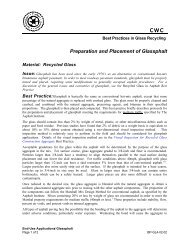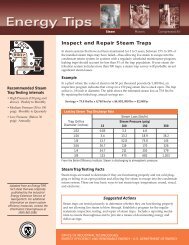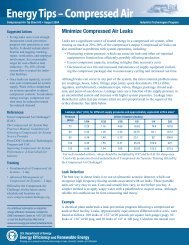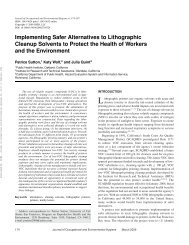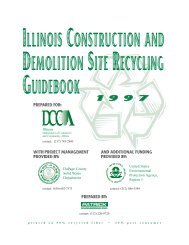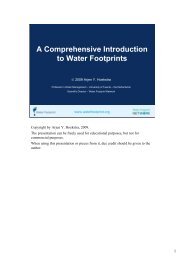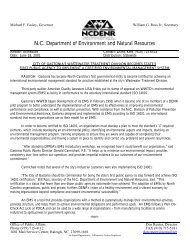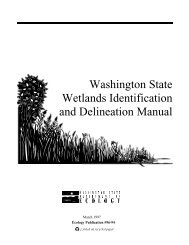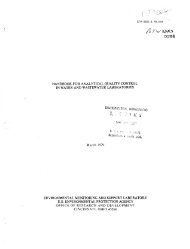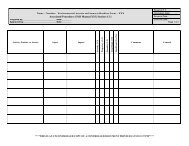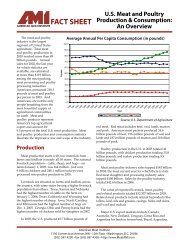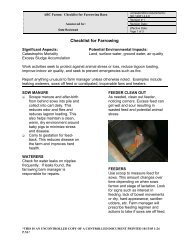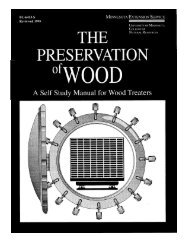Woven Fabrics - infoHouse
Woven Fabrics - infoHouse
Woven Fabrics - infoHouse
- No tags were found...
Create successful ePaper yourself
Turn your PDF publications into a flip-book with our unique Google optimized e-Paper software.
Figure 10- 1 WeavingWarp Cross Section10-2 <strong>Woven</strong> <strong>Fabrics</strong>
Basic Functions Of A loom Or Weaving MachineWarp and FillingIW~~mFabrlcs 10-5
Flow Of Yarn On A LoomWarp BeamBack Rest (Breast Beam)Drop WiresHarness and HeddlesReedClothFellFabricRollIW/-warp104 <strong>Woven</strong> Fa-
Figure 10-2 Shedding FormationnW~~mFabrlcs 10-5
Shedding MotionDefinitionShedding is a function of weaving involving the lifting of harnessescontaining warp ends in order to provide a shed opening for fillinginsertion and to control design.Types Of SheddingCam Shedding- Employs circular profiled cams to lift the harnesses- Usually 6 - 8 hamesses.- Plain, simple twill and satin weaves- High loom speeds- Lifting plan relatively easy to changeDobby Shedding- Employs a chain of wooden bars with pegs inserted or plasticpaper with holes inserted or computer controls- Usually 8 - 24 harnesses- More complex twill and satin weaves- Small geometric figures and spot weaves- Pattern stripes- Slower loom speeds than cam shedding- Lifting plan more dimcult to change10-6 <strong>Woven</strong> Fabrlcs
Jacquard Shedding- Employs cardboard cards with holes inserted, plastic paper withholes, or computer controls- Individual warp ends or groups of warp ends are lifted without theuse of harnesses- Design capability is virtually unlimited- Can produce very large design repeats- Slowest loom speeds- More expensive fabricsW O V Fabrtcs ~ 10-7
WaterProjectileRapieri;-J$2 PLp ;,'\ IOther'*,Filling Insertion Rate10-8 <strong>Woven</strong> Fabrlcs
<strong>Woven</strong> Fabric ProductionRunning TimeEfficiency (Em = Running Time + Down TimePick DensitvThe number of picks required per unit length of fabric.PicWinch (ppi)Loom Speed?;he number of picks inserted into the fabric per unit time.PicWminute (ppm)Fabric Production =pickdminutepicwinchX= linear yards of fabrichourminuteshour x EFFinchedyard_-WOVWIF~~W 10-9
IFigure 10-3 Rapier SystemsHeadsingle RUM RapierGiver TakerDouble Flex Rapiers10-1 0 WOVWI Fabh
Figure 10-4 Rapier Filling Insertion System<strong>Woven</strong> Fabrlcs 10-1 1
Figure 10-5 Projectile Filling Insertion System_-10-12 woven Fabrlcs
Figure 10-6 Air-Jet Filling Insertion Systems--<strong>Woven</strong>Faklcs 10-13
Figure 10-7 Air-Jet Filling Insertion: SchematicRepresentation of the Pick Insertion Sequence10-14 <strong>Woven</strong> Fabrlcs
Beat-Up MotionFunctions of the reed- Keep ends parallel and in the same position- Beat the filling yarn into the fabric- Provide some control for filling insertionNote: Reed No. =EnddinchEndddentImplications of increased beat-up- Filling density- Warp tension- Noise and vibration- Fabric structure and properties<strong>Woven</strong> Faklcs 10-15
Figure 10-8 Beat - Up10-16 W O V FabtlCS ~
Wo~enFabrlc~ 10-17PB
Warp ControlLet-off- Controls rate of yarn removal from the warp beam- Controls tension of warp endsTake-up- Controls pick spacing and rate the fabric is delivered fromthe loom- Must be synchronized with the Let-Off for proper yam tensioncontrol during weaving10-18 <strong>Woven</strong> Fabrlcs
<strong>Woven</strong> Fabric DesignI. Fabric Constntction FactorsThe following factors show the detailed information that isnecessary in producing a woven fabric for a specified end use.k TypeofFiber1. Natural2. Man-madeB. Type ofyarn1. count2. Structure3. Twist4. ColorC. Fabric Set (Construction)1. Fabric count2. Yarn count (warp and filling)3. Cover4. Fabricwidth5. Fabric weightD. Yarn Arrangement in Fabric1. Denting: regular or irregular2. Type of yam: same or different for warp and filling3. Warp beams: one or more with same or Merent tensions__E. Weaving1. Designa. Weaveb. DraRplanc. Camplan<strong>Woven</strong> <strong>Fabrics</strong> 10- 19
2. Type of loom3. Special loom requirementsF. Surface Alteration (Finishing)1. Printing2. Chemical treatment3. Mechanical treatment4. CoatingII, Basic WeavesA. Plain Weave and Its Derivatives1. Warp rib weave2. Filling rib weave3. Basket weaveB. TwillC. SatinI&Weave Variations are Produced ByA. Different ply, count or texture of yarnsB. Equal or unequal size and count for warp nd fillingC. Equal or unequal yam count for warp and fillingD. Equal yam size and unequal or dented spacingE. Equal yam count for warp and filling and unequal yam size- .F. Interlacing different patterns and weave effectsG. Interlacing different colored yarns10-20 woven <strong>Fabrics</strong>
EZenents of the WeaveA Risers and sinkersB. Binding pointsC. FloatsD. Intersections- V. Use of Design PaperA Graphically shows the interlacing of warp and filling yarns1. Vertical row of squares represents a warp end.2. Horizontal row of squares represents a pick.B. Interpretation of design on paper1. End over pick2. Pick over endC. Repeat of a weavewoven Fabrlcz, 10-21
.I~Figure 10-9 Fabric Weaves1 1 1 1 1 1 I I III1 1I I1 I I IIII 1 1 - I I I II I I,- I I II 1 1 1 I I 1 1 1 I I 1 II,10-a <strong>Woven</strong>Fabrlcs
UU<strong>Woven</strong>Fabrlcs 10-23
Figure 1040 Twill WeavesL10-24 W O V FabrlCS ~
Figure 10- 1 1 Basket Weave and Twill Weaves<strong>Woven</strong> FaMa 10-25
Figure 10-12 Twill Weaves3/1 RH.MI 41 R.H.MiQ10-26 W O V FabIkS ~
Wo~~FabtkS 10-27
Figure 10- 13 Warp Satin And Filling Satin (Sateen)10-28 W O V FabrfCS ~
PumoseFabric GradingClassLfy fabric according to quality, first quality, second quality, etc.Supply information to management as to the qualitiesbeing produced.Fabric Qual it?Physical Properties - SpecificationMaterial Defects<strong>Woven</strong>Fabrlcs 10-29
IPhysical PropertiesoWeight0Construction0Strength - tensile and tear0Abrasion resistance and pilling0Dimensional stability (heat, washing, dry cleaning)Appearance &rwashingFastness (wash, light, gas)L-Stiffness and drape (handle)Sewability (seam strength and resistance to slippage)10-30 WOV- FabkS
Fabric DefectsWarn ImnerfectionsBroken or Missing EndCoarse EndSlubsStreaksUneven YamUneven WeavingReed MarksMisdrawSlack EndOthersFilling ImnerfectionsBroken PickMissing PickCoarse PickSlubsStreaksMixed Filling, Barr6Bar (start up, thick, thin)Jerk - Ins (slough-off)Kinky FillingBias, Bowed, SkewedFilling OthersW O V Fabtic~ ~ 10-31
Fabric Structure vs. Fabric ExpectationsTypes of fibers or yarns, method of fabric construction and finishesapplied interrelate in the production of a fabric. When one of thesecomponents is changed, the fabric will change and will affectthe fabrics.0 WeightHand0 DrapabilityPerformance Expectations0 AppearancemCovering PowerSurfaceTextureThicknessLusterStrengthFlexibilityResiliencyWarmth0 Affbity to DyestuffEndUsecostThese are basic inherent properties to be found in a given fiber, yam,finish, and fabric construction. One or more of these properties may bemodified or altered to achieve the desired results for a fabric applicableto a particular end use or design.



